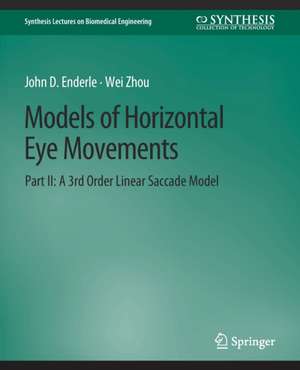Models of Horizontal Eye Movements, Part II: A 3rd Order Linear Saccade Model: Synthesis Lectures on Biomedical Engineering
Autor John Enderle, Wei Zhouen Limba Engleză Paperback – 25 mar 2010
Din seria Synthesis Lectures on Biomedical Engineering
- 17%
 Preț: 362.02 lei
Preț: 362.02 lei - 15%
 Preț: 522.24 lei
Preț: 522.24 lei - 5%
 Preț: 364.74 lei
Preț: 364.74 lei - 5%
 Preț: 525.87 lei
Preț: 525.87 lei - 15%
 Preț: 636.80 lei
Preț: 636.80 lei -
 Preț: 382.95 lei
Preț: 382.95 lei -
 Preț: 268.83 lei
Preț: 268.83 lei -
 Preț: 260.77 lei
Preț: 260.77 lei -
 Preț: 266.32 lei
Preț: 266.32 lei -
 Preț: 265.18 lei
Preț: 265.18 lei -
 Preț: 262.47 lei
Preț: 262.47 lei -
 Preț: 204.76 lei
Preț: 204.76 lei -
 Preț: 268.66 lei
Preț: 268.66 lei -
 Preț: 262.47 lei
Preț: 262.47 lei -
 Preț: 206.84 lei
Preț: 206.84 lei -
 Preț: 321.54 lei
Preț: 321.54 lei -
 Preț: 192.05 lei
Preț: 192.05 lei -
 Preț: 261.32 lei
Preț: 261.32 lei -
 Preț: 261.53 lei
Preț: 261.53 lei -
 Preț: 206.84 lei
Preț: 206.84 lei -
 Preț: 349.36 lei
Preț: 349.36 lei -
 Preț: 260.95 lei
Preț: 260.95 lei -
 Preț: 204.76 lei
Preț: 204.76 lei -
 Preț: 391.02 lei
Preț: 391.02 lei -
 Preț: 268.83 lei
Preț: 268.83 lei -
 Preț: 205.92 lei
Preț: 205.92 lei -
 Preț: 346.48 lei
Preț: 346.48 lei -
 Preț: 264.41 lei
Preț: 264.41 lei -
 Preț: 384.48 lei
Preț: 384.48 lei -
 Preț: 259.04 lei
Preț: 259.04 lei -
 Preț: 260.95 lei
Preț: 260.95 lei -
 Preț: 261.32 lei
Preț: 261.32 lei -
 Preț: 158.66 lei
Preț: 158.66 lei -
 Preț: 267.86 lei
Preț: 267.86 lei -
 Preț: 207.65 lei
Preț: 207.65 lei -
 Preț: 205.92 lei
Preț: 205.92 lei -
 Preț: 268.66 lei
Preț: 268.66 lei -
 Preț: 322.31 lei
Preț: 322.31 lei -
 Preț: 205.70 lei
Preț: 205.70 lei -
 Preț: 226.22 lei
Preț: 226.22 lei - 15%
 Preț: 404.48 lei
Preț: 404.48 lei -
 Preț: 263.28 lei
Preț: 263.28 lei -
 Preț: 383.71 lei
Preț: 383.71 lei -
 Preț: 273.45 lei
Preț: 273.45 lei -
 Preț: 207.06 lei
Preț: 207.06 lei -
 Preț: 263.06 lei
Preț: 263.06 lei -
 Preț: 260.77 lei
Preț: 260.77 lei -
 Preț: 205.33 lei
Preț: 205.33 lei
Preț: 382.57 lei
Nou
Puncte Express: 574
Preț estimativ în valută:
73.21€ • 76.63$ • 60.93£
73.21€ • 76.63$ • 60.93£
Carte tipărită la comandă
Livrare economică 31 martie-14 aprilie
Preluare comenzi: 021 569.72.76
Specificații
ISBN-13: 9783031005152
ISBN-10: 3031005155
Ilustrații: XII, 148 p.
Dimensiuni: 191 x 235 mm
Greutate: 0.29 kg
Editura: Springer International Publishing
Colecția Springer
Seria Synthesis Lectures on Biomedical Engineering
Locul publicării:Cham, Switzerland
ISBN-10: 3031005155
Ilustrații: XII, 148 p.
Dimensiuni: 191 x 235 mm
Greutate: 0.29 kg
Editura: Springer International Publishing
Colecția Springer
Seria Synthesis Lectures on Biomedical Engineering
Locul publicării:Cham, Switzerland
Cuprins
2009 Linear Homeomorphic Saccadic Eye Movement Model and Post-Saccade Behavior: Dynamic and Glissadic Overshoot.- Neural Network for the Saccade Controller.
Notă biografică
John D. Enderle, Biomedical Engineering Program Director and Professor of Electrical & Computer Engineering at the University of Connecticut, received the B.S., M.E., and Ph.D. degrees in biomedical engineering, and M.E. degree in electrical engineering from Rensselaer Polytechnic Institute, Troy, New York, in 1975, 1977, 1980, and 1978, respectively. After completing his Ph.D. studies, he was a senior staff member at PAR Technology Corporation, Rome, New York, from 1979 to 1981. From 1981-1994, Enderle was a faculty member in the Department of Electrical Engineering and Coordinator for Biomedical Engineering at North Dakota State University (NDSU), Fargo, North Dakota. Dr. Enderle joined the National Science Foundation as Program Director for Biomedical Engineering & Research Aiding Persons with Disabilities Program from January 1994-June 1995. In January 1995, he joined the faculty of the University of Connecticut (UConn) as Professor and Head of the Electrical & Systems EngineeringDepartment. In June 1997, he became the Director for the Biomedical Engineering Program at UConn. Dr. Enderle is a Fellow of the Institute of Electrical & Electronics Engineers (IEEE), the current Editor-in-Chief of the EMB Magazine, the 2004 EMBS Service Award Recipient, Past-President of the IEEE-Engineering in Medicine and Biology Society (EMBS), EMBS Conference Chair for the 22nd Annual International Conference of the IEEE EMBS and World Congress on Medical Physics and Biomedical Engineering in 2000, a past EMBS Vice-President for Publications & Technical Activities and Vice-President for Member and Student Activities, Fellow of the American Institute for Medical and Biological Engineering (AIMBE), an ABET Program Evaluator for Bioengineering Programs, a member of the Engineering Accreditation Commission, a member of the American Society for Engineering Education and Biomedical Engineering Division Chair for 2005, and a Senior member of the Biomedical Engineering Society. Enderle was elected as a Member of the Connecticut Academy of Science and Engineering in 2003, with membership limited to 200 persons. He is also a Teaching Fellow at the University of Connecticut since 1998. Wei Zhou holds two bachelor’s degrees in mechanical engineering (safety engineering) and electrical engineering from the University of Science and Technology of China, and an MS degree in biomedical engineering from the University of Connecticut. He is pursuing the PhD degree in biomedical engineering at the University of Michigan. His research area involves biomechanics, motor control, and ergonomics.
